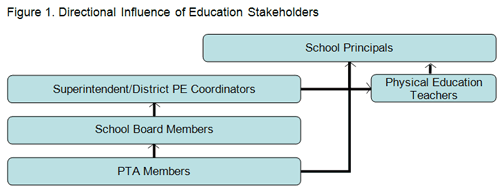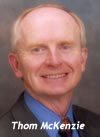 HOLIDAY
GREETINGS FROM pelinks4u! HOLIDAY
GREETINGS FROM pelinks4u!
On behalf of everyone who contributes to
the production of pelinks4u, I wish
you and your families a healthy and enjoyable
holiday season.
This month, we have a guest editorial introducing
readers to a recently released physical education
film. As Thom McKenzie and Monica Lounsbery
explain, they received a grant from the Robert
Woods Johnson Foundation to help improve the
quality of American physical education. With
grant support, Thom and Monica developed a
short promotional video that they invite you
to view on YouTube. Please read their editorial
and watch "Making
the Most of Physical Education."
Let us know what you think.
Last month, we also posted a letter (read
Word
document or web
page)that the Board of the National Association
for Sport and Physical Education (NASPE) asked
pelinks4u to publicize. If you have
not already read and responded to the letter
we encourage you to do so. The times are changing
for our national professional association
and AAHPERD. We encourage you to be a part
of this change and share your thoughts.
Finally, I want to remind you that each month
pelinks4u features some excellent
original articles. This month is no different.
Be sure to scroll down this page and review
this month’s topics.
Remember too, that you are welcome to contact
the authors if you have questions or comments.
And if you have something you'd like to share
with your colleagues don't hesitate to contact
us.
Once again, have a great month and enjoy
the remainder of 2011.
Best Regards,
Steve
Jefferies, publisher pelinks4u
THE MAKING OF "MAKING
THE MOST OF PHYSICAL EDUCATION"
Required physical
education is one of the few settings where
children, particularly those from socio-economically
disadvantaged families, can accrue substantial
amounts of moderate-to-vigorous physical activity
(MVPA) and learn important generalizable movement
and behavioral skills that help them lead
physically active lifestyles.
Over the years,
several physical education curriculum models
have been proposed: developmental education,
humanistic education, play education, personal
meaning and others. The reality, however,
is that most physical education programs do
not emphasize the public health goal of promoting
physical activity. Furthermore, physical education
is often marginalized in schools, where it
suffers from insufficient time allocations,
low subject status, and inadequate financial
and personnel resources.
Within the context
of these challenges, several large-scale school
health and physical education studies have
been conducted. These were rigorously designed
with interventions that were multi-faceted
and included the development and evaluation
of health-optimizing physical education programs
(e.g., SPARK, CATCH, Planet Health). Compared
to control schools, moderate-to-vigorous physical
activity (MVPA) during physical education
in intervention schools increased by as much
as 18%, even without increasing the frequency
or duration of lessons. These studies produced
compelling evidence that these intervention
programs increased physical activity and can
contribute to public health goals more than
traditional physical education programs.
While Evidence-Based
Physical Education (EBPE) programs exist,
and their adoption has been shown to be feasible
and effective, they won't have any impact
on physical activity or obesity if they are
not used in schools. To date, widespread school
adoption has not occurred. We recently conducted
a study to describe facilitators and obstacles
to elementary school adoption of EBPE. In
it Principal and physical education teacher
pairs from 154 schools (75 from Adopter schools,
79 Non-Adopter schools) from 34 states completed
questionnaires.
Among our most
interesting but sad findings was that physical
education programs are rarely evaluated, and
that while school principals play a major
role in the adoption of school curricula they
had limited in-depth familiarity with their
school's physical education program. We also
learned that principals rated aspects of their
current physical education programs very highly
(even though they often didn't know the fine
details about them). Thus, principals would
not be likely to initiate or support the adoption
of evidence-based PE programs unless there
was some outside stimulus (e.g., education,
marketing).
Our results also
showed that physical education teachers in
Adopter Schools were strong catalysts for
their school adopting EBPE. We concluded that
dissemination efforts targeting physical education
teachers should continue, but more efforts
to increase principals' physical education
knowledge were very much needed because principals
have the authority to require PE program evaluation
and to adopt programs. Our study also highlighted
that well-planned and strategic dissemination
efforts were needed in order to successfully
reach principals.
We know that
changes in PE policies and practices hinge
on informing and persuading educational decision
makers. With site-based management, school
principals are the major decision makers in
elementary schools as they often have the
latitude to make decisions in accordance with
what they believe are the needs of their individual
schools. Our study showed that principals
often lacked general familiarity with their
school's physical education program, and very
few were even aware that EBPE programs existed.
Given their important
decision-making function, we are focusing
the dissemination of our study findings to
elementary school principals AND to those
known to influence their decisions, including
physical education teachers, superintendents/district
physical education coordinators, school board
members, and members of the PTA. Figure
1 illustrates our thinking on the directional
influence education stakeholders have in this
regard. Each of these stakeholders has the
potential to influence the adoption of quality
physical education, but they need to be informed
and encouraged to act.

We were subsequently
awarded a grant from Active Living Research,
a National Program of the Robert Wood Johnson
Foundation, and some supplemental funding
from the Nevada State Health Division to help
disseminate the findings of our study and
to help improve physical education in the
United States. For our work we assembled a
team of project consultants that included
physical education teachers, an elementary
principal, a school board member, a district
superintendent, and a staff member of the
national PTA to help us to identify strategic
translation and dissemination tactics.
One of the tactics
recommended by the consultants was to develop
a video - one that was short, informational,
and provided a call to action. We were told
that to maintain the interest of administrators
the video needed to address the linkage between
physical activity and academic achievement.
Initial reviewers also suggested that the
video would be more impactful if it included
"child’s voices."
The video
is now posted on YouTube for anyone to
see and use.
Please check
out it out. If you like it, please share it
with others. If you don't like it, let us
know. We love to debate, and look forward
to meeting you at an upcoming conference.
- Thom
McKenzie; Monica Lounsbery
ABOUT THE AUTHORS
Thom McKenzie, PhD., is a former public school
physical education and health teacher, coach,
and administrator. He is Emeritus Professor
of Exercise and Nutritional Sciences at San
Diego State University, author of over 200
papers, Fellow for four professional organizations,
and currently works on numerous federally-funded
research programs focusing on physical activity,
physical education, and obesity.
Monica Lounsbery, Ph.D., is a Professor at
the University of Nevada, Las Vegas, where
she directs the Physical Activity Policy Research
Program. Her recent studies of facilitators
and barriers to school adoption of evidence-based
physical education, research translation on
improving school physical education, and school
physical activity policy assessment have been
funded by Active Living Research. Dr. Lounsbery
has published extensively on school physical
education and physical activity programs and
led national committees on school policy advocacy
targets and strategies.
BIBLIOGRAPHY
Lounsbery,
M. A., McKenzie, T. L., Trost. S. G., &
Smith, N. J. (2011). Facilitators and barriers
to adopting evidence-based physical education
in elementary schools. Journal of Physical
Activity & Health, 8(Suppl 1), S17-S25.
McKenzie,
T. L., & Lounsbery, M. A. F. (2009). School
physical education: The pill not taken. American
Journal of Lifestyle Medicine, 3(3),
219-225. Reprinted in CAHPERD Journal,
2009, 7(4), 30-35. |














 HOLIDAY
GREETINGS FROM pelinks4u!
HOLIDAY
GREETINGS FROM pelinks4u!


